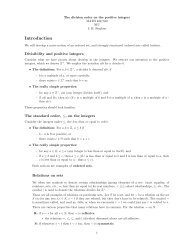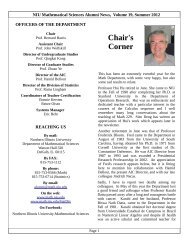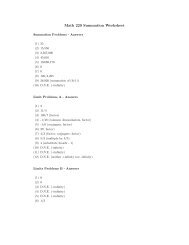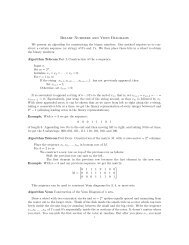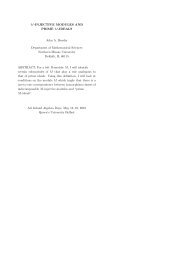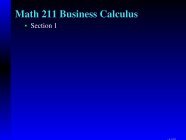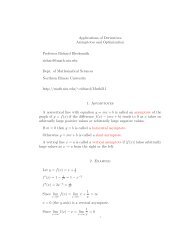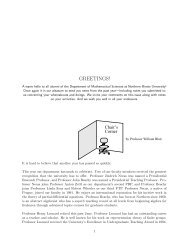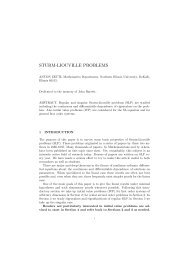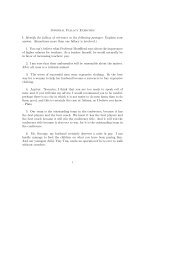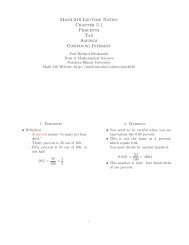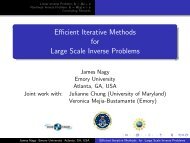abstract algebra: a study guide for beginners - Northern Illinois ...
abstract algebra: a study guide for beginners - Northern Illinois ...
abstract algebra: a study guide for beginners - Northern Illinois ...
You also want an ePaper? Increase the reach of your titles
YUMPU automatically turns print PDFs into web optimized ePapers that Google loves.
8 CHAPTER 1. INTEGERS<br />
57.†Solve the following system of congruences.<br />
58. Prove that if the system<br />
2x ≡ 3 (mod 7) x ≡ 4 (mod 6) 5x ≡ 50 (mod 55)<br />
x ≡ 1 (mod m) x ≡ 0 (mod n)<br />
has a solution, then m and n are relatively prime.<br />
59.†Use congruences to prove that 5 2n − 1 is divisible by 24, <strong>for</strong> all positive integers n.<br />
Note: This is Problem 1.1.38, which then required a proof by induction.<br />
60. Prove that n 5 − n is divisible by 30, <strong>for</strong> all integers n.<br />
61.†Prove that if 0 < n < m, then 2 2n<br />
+ 1 and 2 2m<br />
+ 1 are relatively prime.<br />
1.4 Integers Modulo n<br />
The ideas in this section allow us to work with equations instead of congruences, provided<br />
we think in terms of equivalence classes. To be more precise, any linear congruence of the<br />
<strong>for</strong>m<br />
ax ≡ b (mod n)<br />
can be viewed as an equation in Zn, written<br />
[a]n[x]n = [b]n .<br />
This gives you one more way to view problems involving congruences. Sometimes it<br />
helps to have various ways to think about a problem, and it is worthwhile to learn all<br />
of the approaches, so that you can easily shift back and <strong>for</strong>th between them, and choose<br />
whichever approach is the most convenient. For example, trying to divide by a in the<br />
congruence ax ≡ b (mod n) can get you into trouble unless gcd(a, n) = 1. Instead of<br />
thinking in terms of division, it is probably better to think of multiplying both sides of the<br />
equation [a]n[x]n = [b]n by [a] −1<br />
n , provided [a] −1<br />
n exists.<br />
It is well worth your time to learn about the sets Zn and Z × n . They will provide an<br />
important source of examples in Chapter 3, when we begin <strong>study</strong>ing groups. We should<br />
mention that we can use negative exponents in Z × n , because if k < 0 and [x]n �= [0]n, we<br />
can define [x] k n = ([x] −1<br />
n ) |k| .<br />
The exercises <strong>for</strong> Section 1.4 of the text contain several definitions <strong>for</strong> elements of Zn.<br />
If (a, n) = 1, then the smallest positive integer k such that a k ≡ 1 (mod n) is called the<br />
multiplicative order of [a] in Z × n . The set Z × n is said to be cyclic if it contains an element of<br />
multiplicative order ϕ(n). Since |Z × n | = ϕ(n), this is equivalent to saying that Z × n is cyclic<br />
if has an element [a] such that each element of Z × n is equal to some power of [a]. Finally,<br />
the element [a] ∈ Zn is said to be idempotent if [a] 2 = [a], and nilpotent if [a] k = [0] <strong>for</strong><br />
some k.



